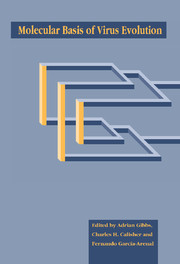Book contents
- Frontmatter
- Contents
- List of contributors
- Editors' preface
- Conference participants
- 1 Introduction and guide
- Part I The impact of viral diseases
- Part II Origins of viruses and their genes
- Part III Sources of virus variation
- Part IV Molecular interactions of viruses and their hosts
- Part V Viruses, hosts and populations
- Part VI Case studies of viral taxa; their systematics and evolution
- 18 Evolution of poxviruses and African swine fever virus
- 19 Molecular systematics of the flaviviruses and their relatives
- 20 Herpesviridae
- 21 Aphthovirus evolution
- 22 Evolution of the Bunyaviridae
- 23 Evolution of the tobamoviruses
- 24 The luteovirus supergroup: rampant recombination and persistent partnerships
- 25 The evolution of the Reoviridae
- 26 Genetic variation and evolution of satellite viruses and satellite RNAs
- 27 Molecular evolution of the retroid family
- 28 Adaptation of members of the Orthomyxoviridae family to transmission by ticks Patricia
- 29 The Order Mononegavirales: evolutionary relationships and mechanisms of variation
- 30 The molecular evolution of the human immunodeficiency viruses
- 31 Molecular evolution of papillomaviruses
- 32 Molecular systematics of the Potyviridae, the largest plant virus family
- 33 Evolution of alphaviruses
- 34 Evolution of influenza viruses: rapid evolution and stasis
- Part VII Techniques for viral systematics
- Index
34 - Evolution of influenza viruses: rapid evolution and stasis
Published online by Cambridge University Press: 04 May 2010
- Frontmatter
- Contents
- List of contributors
- Editors' preface
- Conference participants
- 1 Introduction and guide
- Part I The impact of viral diseases
- Part II Origins of viruses and their genes
- Part III Sources of virus variation
- Part IV Molecular interactions of viruses and their hosts
- Part V Viruses, hosts and populations
- Part VI Case studies of viral taxa; their systematics and evolution
- 18 Evolution of poxviruses and African swine fever virus
- 19 Molecular systematics of the flaviviruses and their relatives
- 20 Herpesviridae
- 21 Aphthovirus evolution
- 22 Evolution of the Bunyaviridae
- 23 Evolution of the tobamoviruses
- 24 The luteovirus supergroup: rampant recombination and persistent partnerships
- 25 The evolution of the Reoviridae
- 26 Genetic variation and evolution of satellite viruses and satellite RNAs
- 27 Molecular evolution of the retroid family
- 28 Adaptation of members of the Orthomyxoviridae family to transmission by ticks Patricia
- 29 The Order Mononegavirales: evolutionary relationships and mechanisms of variation
- 30 The molecular evolution of the human immunodeficiency viruses
- 31 Molecular evolution of papillomaviruses
- 32 Molecular systematics of the Potyviridae, the largest plant virus family
- 33 Evolution of alphaviruses
- 34 Evolution of influenza viruses: rapid evolution and stasis
- Part VII Techniques for viral systematics
- Index
Summary
Introduction
Influenza is the paradigm of a viral disease that relies on continued evolution of the virus to cause annual epidemics and occasional pandemics of disease in humans. The gene pool of influenza A viruses in aquatic birds provides all the genetic diversity required for the emergence of pandemic influenza virus for humans, lower animals and birds. In humans, pigs and horses, influenza A viruses show both antigenic drift and genetic shift (Webster et al., 1992). In contrast, there is emerging evidence that avian influenza viruses are in evolutionary stasis. This review reports that rapid evolution in influenza A viruses in humans and other mammals has continued since the beginning of recorded medical history and depends on periodic introductions of gene segments or entire influenza viruses from the avian influenza virus gene pool. In aquatic wild birds, influenza virus appears to be fully adapted to its host and causes no disease signs. Thus, understanding the ecology of influenza viruses in the reservoir of aquatic birds is essential if we wish to find ways to intervene and reduce or prevent the occasional catastrophic pandemics such as the one that decimated the human population of the world in 1918 after the appearance of ‘Spanish’ influenza.
Host-specific evolution of influenza viruses
It is likely that the NP protein gene determines host range (Scholtissek et al., 1985; Tian et al., 1985; Snyder et al., 1987); consequently NP gene evolution and host taxonomy has been studied (Gorman et al., 1990a, 1991; Gammelin et al., 1990).
- Type
- Chapter
- Information
- Molecular Basis of Virus Evolution , pp. 531 - 544Publisher: Cambridge University PressPrint publication year: 1995
- 7
- Cited by



